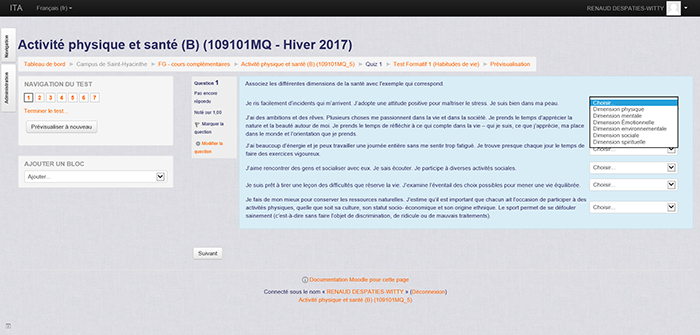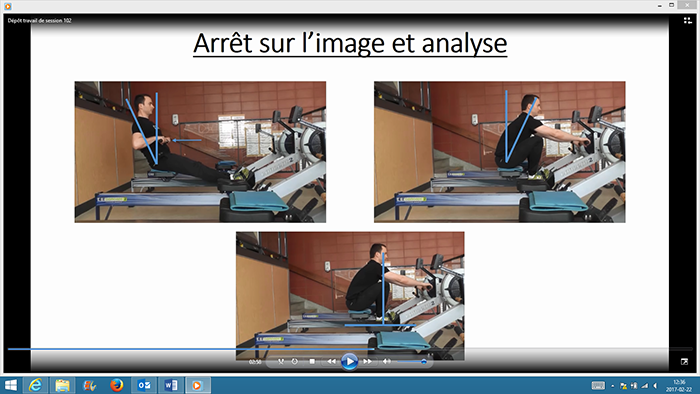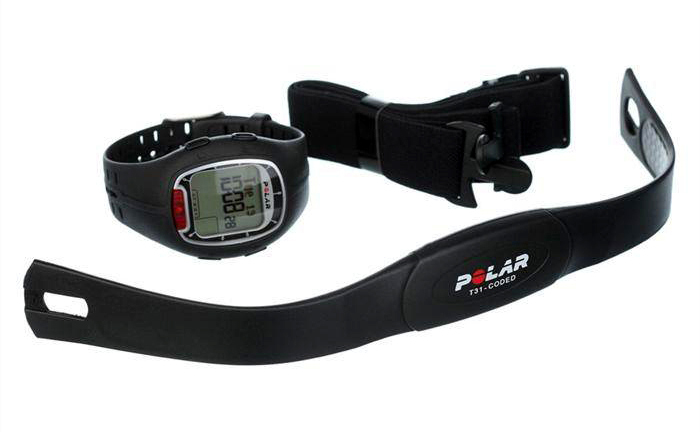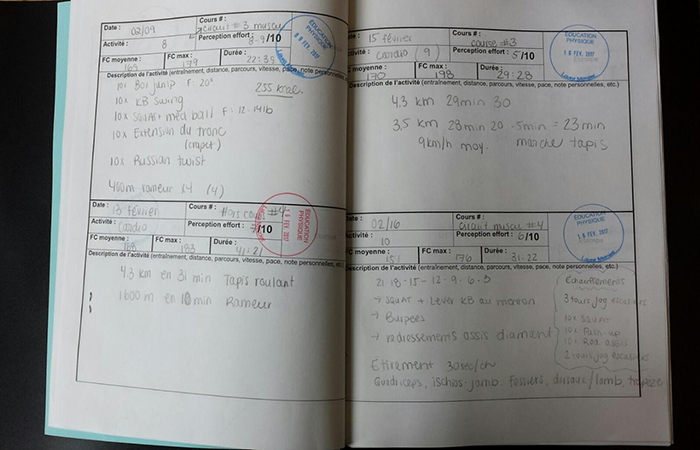Physical Education and the Flipped Classroom: A Custom Training Program Thanks to Moodle
At the turn of the century, seeing obesity, cardiovascular illnesses and type II diabetes rates that were skyrocketing within the population, the ITA (Institut de technologie agroalimentaire) decided to take on the issue of physical inactivity that was, and still is, affecting our society. We decided to focus the physical education courses which are mandatory for the DCS/DEC on adopting healthy life habits – more specifically focusing on regular physical activity (3 workout sessions per week).
To meet this objective, we were looking for a way to offer more theoretical content without compromising the time dedicated to weight training in the gym. We opted to use a flipped classroom approach thanks to Moodle. This initiative, which was combined with the use of Heart rate monitor watches, allowed us to develop an original and customized approach to training, while also helping students to become more autonomous.
Promoting Healthy Life Habits… Within a Short Timeframe
One of the special features of the ITA de Saint-Hyacinthe is that students can’t take a phys ed. course “of their choosing.” The course weighting means that students generally have no more than 2 one-hour training sessions per week. A part of the course also needs to be reserved for theory:
- The course Physical Activity and Health (101) provides an initiation to running and indoor rowing, but the theory is transferable to any cardiovascular activity. The theoretical content covers healthy lifestyle habits and different ways of training.
- The coursePhysical Activity and Effectiveness (102) is geared towards the improvement of techniques and cardiovascular endurance for rowing and running.
- The course Physical Activity and Autonomy (103) provides an introduction to weight training. By the end of the term, students have to create their own workout program and present it to the others. They have to properly understand the different techniques that are covered.
Each physical education course contributes to the development of the student’s autonomy with regards to leading a healthy lifestyle. Our challenge was to let students take advantage – as much as possible – of the training time that was planned within their schedule while also covering the theoretical aspects. Finally, we asked ourselves if there was a different way to present certain technical aspects, like body alignment or proper technique for weightlifting, while to support students throughout their studies, regardless of their learner type whether visual, auditive or kinesthetic.
Moodle to the Rescue
Flipped class pedagogy appeared like the ideal solution, since it allowed us to present theoretical elements under the guise of preparatory content. To develop this approach, we turned to Moodle. We uploaded the theoretical content to Moodle which allowed students to access it from home!
Both of us are a bit “techy” by nature:
- Laura had already experimented with Moodle as a student as part of a distance education course, but it was her first time using it as a teacher.
- Renaud had never used Moodle before: This was a first for him! In his third semester as a teacher, however, he was chosen for an ICT mandate to create pedagogical tools.
Thanks to the support of our Education Advisor and IT REP, Jacques Lalumière, we decided to use the tools that are offered within Moodle and some of the newer features of PowerPoint.
We first started developing a series of shortvideo clips that were accompanied by an informational PowerPoint document for the 103 course, since students are evaluated on their weightlifting technique. During the practical classes, they experimented with different muscle training routines where the various techniques to be evaluated were explained, demonstrated and practiced. The learning was therefore taking place in the heat of the action. The video clips were created tosupport learning and study.
An example of an explanatory video demonstrating the technique for a squat (in French).
First and foremost, the video clips addressed a need for theoretical learning, but our approach was also meant to be functional:
At the ITA, we train students that will develop their competency within the agricultural sector: Maintaining a high level of fitness is essential to do their work. We try to recreate “everyday” movements and training sessions that don’t require a lot of equipment and take the reality of our clientele into account.
We then developed the flipped approach for the 101 and 102 level courses. In the 101 course we developed PowerPoint slideshows to present the theory. At the end of each module, we invited students to answer ashort interactive and formative quiz.

A formative questionnaire on Moodle for the Physical Activity and Health (101).
In the 102 course, Moodle allows us to accompany the students during the development of their term project. They need to film themselves performing certain sequences of indoor rowing and running. Then, they present a self-evaluation of their technique. The students use a video camera or their cell phone to film themselves in HD. Next, they use theMovie Maker software to edit their videos, namely to:
- Edit the scenes
- Create a slow-motion effect
- Pause and highlight certain frames
- Add vectors or annotate the video

An example of images that have been isolated to analyse the indoor rowing technique.
The students also need to fill in a document that contains an analysis chart for their technique to accompany the videos.

Example of an analysis chart for running.
This assignment is divided into 3 steps to allow us to evaluate the improvement of the student’s technique over the semester. For each assignment submission, the students upload their folder (with videos and analysis documents) to Moodle. We add our comments and annotations directly within the document and upload it again to Moodle so that the students can review it and improve their analysis the next time they submit their assignment.
Tutorials to Accompany the Students
Our students were generally receptive to the idea of the video capsules when they were introduced as the term project. Some students were a bit worried because they were less familiar with the web and using the Moodle platform. However, over a few semesters Renaud created tutorials that showed them how to proceed, accompanying them step by step. The students felt that they were well-guided.
An excerpt of a tutorial explaining how to edit a video for a technique analysis assignment for rowing.
A Heart Rate Monitor Watch to Facilitate the Supervision of Students

A special feature of our course is that the only mandatory equipment for students, other than their uniforms and running shoes, was a Heart Rate Monitor watch that was hooked up to a cardiac sensor that attaches to your chest, which allows you to record different information during the workout. Right from the 101 course, the students have to buy a heart rate monitor watch with the following functions:
- Records the length of a workout
- Indicates the average and maximum heart rate of the user
- Specifies the date and time of the workouts
This data remains available for the duration of their studies, since the watch is used for each of our 3 phys ed courses. This facilitates the supervisions of the students on 2 levels:
- We can ensure that the intensity of the workout is sufficient for the students during the practical classes. Each training session is recorded and detailed in a training journal, along with the data from the watch (average heart rate and maximum heart rate during the workout). In addition, the students have to do a 3rd workout each week on their own time. They need to record this session on the watch to prove that they did their workout, at the level of intensity recommended by the teacher in order to promote cardiovascular improvement. The detail of this workout is also recorded in the training journal. The data that is collected allows each student to customize their goals for improvement, while being realistic. The watch and the training journal are complementary tools that allow you to follow the evolution of each student.

An example of the training journal containing the detail of a workout session that was held in class and at home.
- For the students, the heart rate monitor watch allows them to self-regulate. They can keep and review their data to measure their progress from one semester to another. For many of the students, this becomes a personal motivation factor and an indispensable tool for training at the right intensity. The training journal also serves as input for workout ideas once the 3 courses are finished. Many students decide to keep it for their future physical activities.
Evaluating Individual Progress
The distance covered in running and rowing during final evaluations, are standardized, but they are increased each semester. In the 103 course, weight training replaces rowing. However, the goals for each course are customized and adapted to each student, according to their shape. This personal objective is established using VO2max obtained during the previous semester: it should improve during the 101 and 102 courses and be maintained in the 103 course.
Positive Impact on the Students
We have already noticed the positive impact of our flipped class pedagogy after only 2 years. For example, we observed higher retention rates for the theory in the 101 class, which had positive repercussions for the subsequent phys ed courses:
- The 101 course lays the theoretical foundation and provides techniques that will be used in the following courses. We noticed better results once the formative tests were put in place on Moodle for the students that used them.
- In the 102 class, the video clips allowed students to develop critical abilities and their analytical abilities. This exercise also allowed them to significantly improve the effectiveness of their technique.
- For the 103 course, we noticed that students had a better understanding of the muscular system thanks to the explanatory video clips that we prepared and the optimized and active use of training time. We noticed an additional benefit of this approach in that the student presentations in front of the class were of an exceptional quality.
When students create their own weightlifting routine and present it to their peers, the explanations that are given are often comparable to those provided by personal trainers in fitness centres! Of course, they don’t have as much theoretical knowledge and techniques as a certified trainer, but they have mastered a certain block of exercises. They are able to explain a technique in detail, to name the principal muscle groups that are targeted by the exercise, to provide a demonstration and correct students that are trying out the technique, while also pushing them to maintain a certain level of intensity.
Finally, another positive aspect of our approach that is an important component is the level of autonomy that the students develop that gives them the desire to continue their physical training after their college studies are over. They can use their heart rate monitor watch to maintain or continue to improve their physical conditioning, but above all, stay active and healthy!
Next Steps: Towards a Digital Training Journal
For the moment, the training journal is paper-based. We are currently thinking about how to offer the journal in a digital format, for environmental reasons. Since we have to approve each training session with a stamp (blue for in-class workouts, red for training at home), we need to reflect upon a digital training journal that we can verify, while also ensuring that students fill it out right after a class or workout. Please feel free to suggest some ideas to us!

